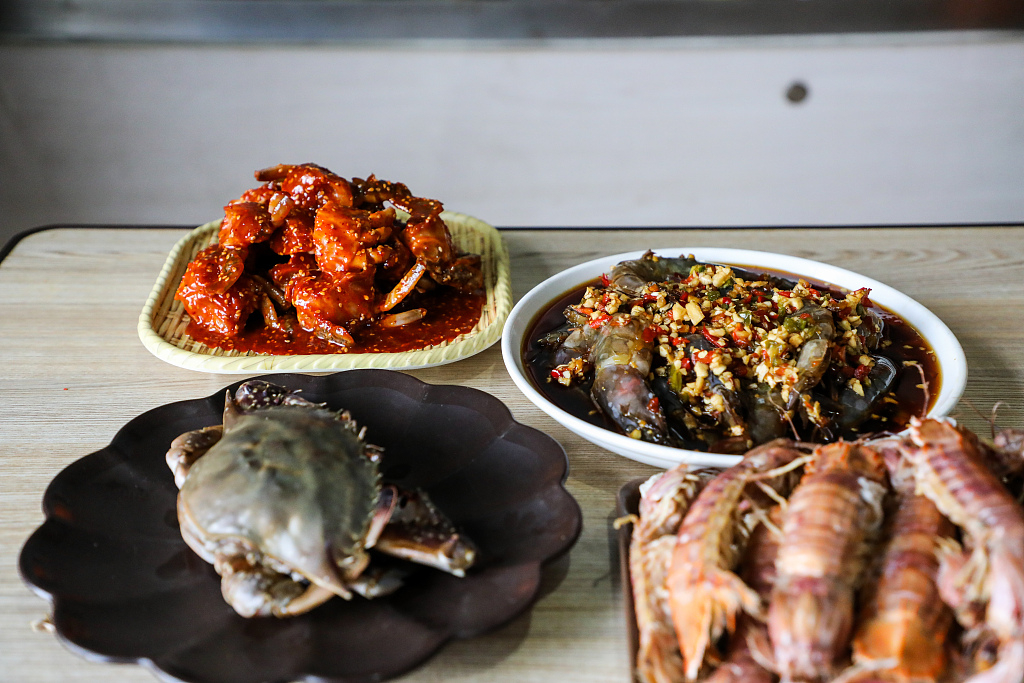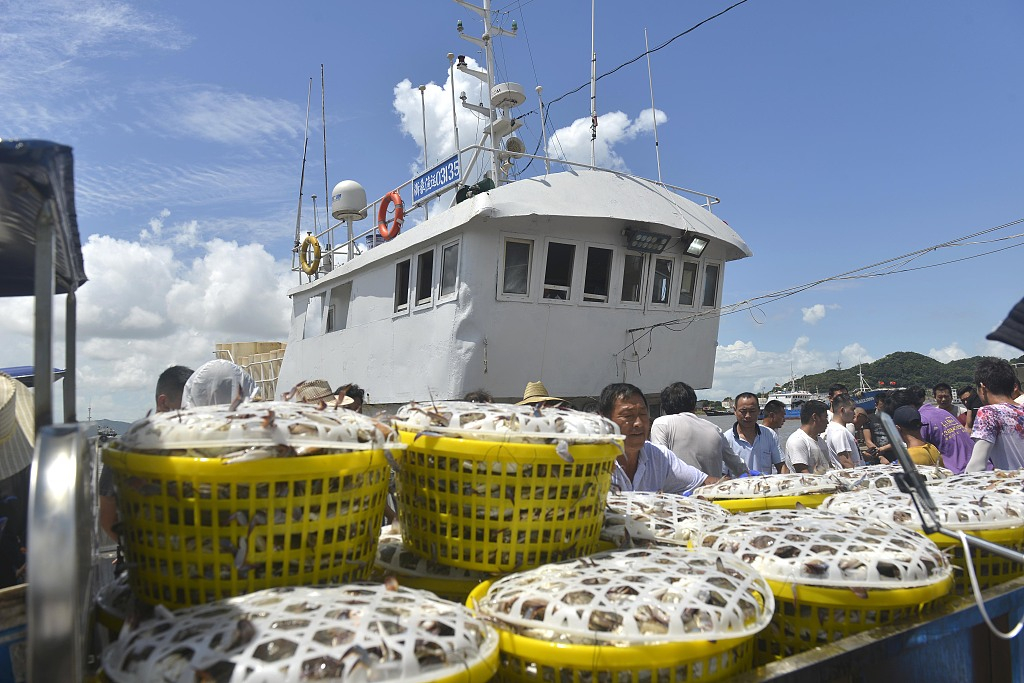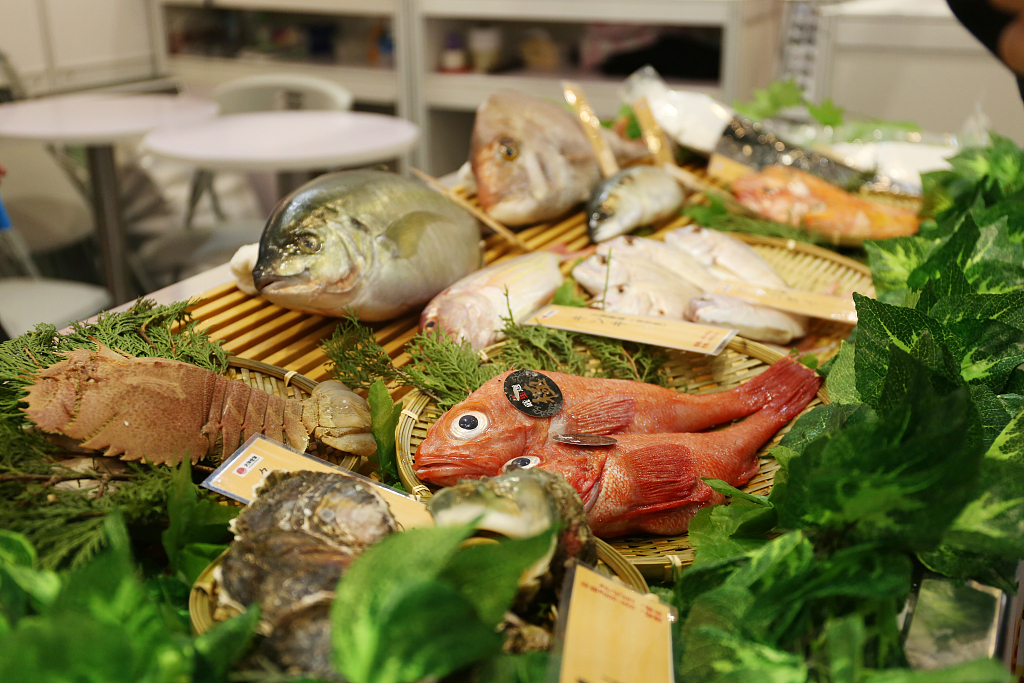Only 30 years ago, seafood was a luxury reserved for special occasions and enjoyed by the wealthy few in China. Today, it is the go-to food choice at business banquets and family gatherings around the country.
A recent e-commerce report showed that Chinese shoppers bought 16.9 billion yuan (2.4 billion U.S. dollars) worth of seafood products online in the first half of 2019, a 22.9 percent increase on the same period last year.
The nation's appetite for fresh seafood is growing rapidly as living standards rise. According to China's Ministry of Agriculture, seafood consumption per capita in the country has surpassed pork, a traditional source of protein in Chinese diet.
"In the past, (Chinese) people were used to eating meat. Seafood was often considered an expensive delicacy," said Yang Guiqing from the Ocean Foods Committee of China Food Industry Association (CNFIA).

Seafood is becoming an increasingly popular alternative to meat in China. /VCG Photo
Seafood is becoming an increasingly popular alternative to meat in China. /VCG Photo
Dietary change and the Chinese public's growing health awareness have contributed to the increased popularity of seafood, which is rich in unsaturated fatty acids and known to have many health benefits, Yang said. The Chinese Dietary Guidelines, published by the Chinese Nutrition Society, recommends a daily intake of 40-75 grams of fish and seafood products per person.
But currently, only a small number of people in China eat the recommended amount, Yang told CGTN. "That's where the potential is for the seafood industry."
The seafood business has tremendous potential in China, according to academics and industry insiders at the 2019 Forum for China Ocean Foods Industry in Fuzhou, southeast China's Fujian Province last Friday.

The 2019 Forum for China Ocean Foods Industry is held in Fuzhou, southeast China's Fujian Province, November 29, 2019. /CGTN Photo
The 2019 Forum for China Ocean Foods Industry is held in Fuzhou, southeast China's Fujian Province, November 29, 2019. /CGTN Photo
This is good news for seafood importers and exporters everywhere. Chinese customs data show trade volume for aquatic products surged 100 times from 0.2 billion U.S. dollars in 1980 to 22.3 billion U.S. dollars in 2018, while trade surplus has shrunk 70 percent in the last five years. This means that China is now buying seafood from other countries faster than it sells.
Barriers to China's seafood trade
But not all exporters are riding the boom at the moment. The U.S. seafood industry is among those sectors hammered by the tit-for-tat trade war with China. A prime example are Maine's lobster farmers, who lost nearly all their Chinese business while their Canadian competitors took over the lucrative market.
Despite the tariffs, Chinese fish exports to the U.S. enjoyed a temporary surge in 2018, as businesses fearing disruption to the supply chain scrambled to stock up before these tariffs took hold. The crunch came in 2019, after most goods traded between the two countries, including seafood, were subjected to fresh tariff hikes amid escalating trade tension. In the first nine months of 2019, bilateral seafood trade shrank nearly 30 percent.
A speaker at the Fuzhou forum pointed out that Chinese fish exporters have already faced a myriad of trade barriers. However, the country's well-established supply chain is not easy to replace. Now given China's huge demand for imported seafood, it is obvious who has more to lose.
"The China-U.S. trade war is only one of a multitude of trade barriers (for Chinese fishery exports)," said Chen Shuping, an expert for the State Council Customs Tariff Committee who led the fisheries negotiations during China's WTO accession talks.
According to Chen, the barriers from the U.S. in particular long predated Trump's trade war, such as the anti-dumping measures on Chinese shrimps in place since 2004 and the U.S. Food and Drug Administration (FDA)'s Import Alert on imported agriculture products due to food safety concerns.
In November, after many rounds of negotiations with Chinese customs authorities, the FDA has officially recognized China's inspection system for catfish products.

Fishermen unload their catch on the dock in Zhoushan, east China's Zhejiang Province, August 2, 2019. /VCG Photo
Fishermen unload their catch on the dock in Zhoushan, east China's Zhejiang Province, August 2, 2019. /VCG Photo
China's seafood produce shifting from quantity to quality
When it comes to international trade, neighboring Vietnam has many advantages having entered multiple free trade agreements with major economies, the trade expert noted.
China is the world's biggest fishery and aquaculture producer, but it is not a leading one, said a researcher from Chinese Academy of Fishery Sciences.
In 2019, the country's fishery output is estimated to be over 1.3 trillion yuan (188 billion U.S. dollars), with 3.52 percent annual compound growth expected for the next five consecutive years.
In October, the Chinese government reaffirmed a target to reduce fishing catches to 10 million tons from domestic waters over the next three years. The move signals a shift from quantity to quality, and also a rise in seafood imports.

Fresh seafood on display during China International Import Expo in Shanghai, November 7, 2019. /VCG Photo
Fresh seafood on display during China International Import Expo in Shanghai, November 7, 2019. /VCG Photo
"As China's market opens up, more high-quality seafood products from overseas are coming in and they will boost consumption," Yang said.
With pricier imported seafood products being snapped up, China's domestic seafood industry is still largely low-value-added due to inadequate use of cold chain, a key technology for transporting fresh agriculture products.
"Cold chain usage is 85 percent in the United States. It is less than 20 percent in China," said Professor Xie Jing from Shanghai Ocean University, adding that the fast growing frozen food market will speed up the development of cold chain in China.
Industry insiders meeting in Fuzhou believe that as domestic demand grows, China's seafood industry is shifting from a seller's market to a buyer's market, with increased expectations from consumers on quality and experience.
And that's where, experts say, Chinese seafood companies looking to upgrade need to focus their efforts on in the face of incoming competition.
(Cover photo designed by Qu Bo)